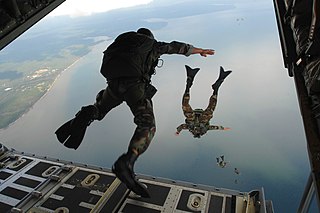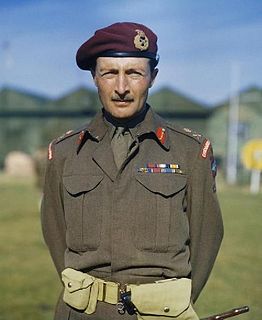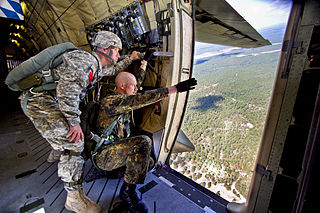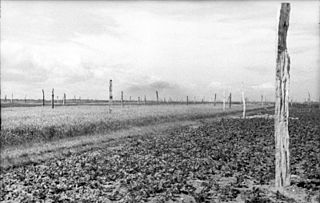 W
WAirborne forces are military units moved by aircraft and "dropped" into battle, typically by parachute, almost anywhere with little warning. Formations are limited only by the number and size of their aircraft; a huge force can appear "out of nowhere" behind enemy lines in minutes, an action known as vertical envelopment.
 W
WAirborne forces are military units moved by aircraft and "dropped" into battle, typically by parachute, almost anywhere with little warning. Formations are limited only by the number and size of their aircraft; a huge force can appear "out of nowhere" behind enemy lines in minutes, an action known as vertical envelopment.
 W
WAir assault is the movement of ground-based military forces by vertical take-off and landing (VTOL) aircraft—such as the helicopter—to seize and hold key terrain which has not been fully secured, and to directly engage enemy forces behind enemy lines. In addition to regular infantry training, air-assault units usually receive training in rappelling, fast-rope techniques and air transportation, and their equipment is sometimes designed or field-modified to allow better transportation within aircraft.
 W
WThe U.S. Army Airborne & Special Operations Museum (ASOM) is part of the United States Army Museum System. Located near Fort Bragg, Fayetteville, North Carolina, it has been open to the public since 2000.
 W
WAn airdrop is a type of airlift, developed during World War II to resupply otherwise inaccessible troops, who themselves may have been airborne forces. In some cases, it is used to refer to the airborne assault itself.
 W
WLieutenant-General Sir Frederick Arthur Montague "Boy" Browning, was a senior officer of the British Army who has been called the "father of the British airborne forces". He was the commander of I Airborne Corps and deputy commander of First Allied Airborne Army during Operation Market Garden in September 1944. During the planning for this operation, he memorably said: "I think we might be going a bridge too far." He was also an Olympic bobsleigh competitor, and the husband of author Dame Daphne du Maurier.
 W
WGlider infantry was a type of airborne infantry in which soldiers and their equipment were inserted into enemy-controlled territory via military glider. Initially developed in the late 1930s by Germany, glider infantry units were used extensively during World War II but are no longer used by any modern military.
 W
WThe glider snatch pick-up technique was used by the Allies of World War II. It allowed military gliders to be launched from a stationary position on the ground by a low-flying powered aircraft, flying low overhead, which did not have to land.
 W
WHigh-altitude military parachuting is a method of delivering military personnel, military equipment, and other military supplies from a transport aircraft at a high altitude via free-fall parachute insertion. Two techniques are used: HALO and HAHO.
 W
WThe insurgency in Khyber Pakhtunkhwa, also known as the War in North-West Pakistan, is an armed conflict involving Pakistan, and armed militant groups such as the Tehrik-i-Taliban Pakistan (TTP), Jundallah, Lashkar-e-Islam (LeI), TNSM, al-Qaeda, and their Central Asian allies such as the ISIL–Khorasan (ISIL), Islamic Movement of Uzbekistan, East Turkistan Movement, Emirate of Caucasus, and elements of organized crime.
 W
WJumpmasters are the expert paratroopers in an airborne unit who train and teach the military techniques for jumping from airplanes. They are responsible for training soldiers who enter Army Airborne School into paratroopers and managing airborne jump operations in airborne units across all branches of services.
 W
WIn military terminology a landing zone (LZ) is an area where aircraft can land.
 W
WAirborne forces are military units moved by aircraft and "dropped" into battle, typically by parachute, almost anywhere with little warning. Formations are limited only by the number and size of their aircraft; a huge force can appear "out of nowhere" behind enemy lines in minutes, an action known as vertical envelopment.
 W
WThe Parachutist Badge was a badge awarded to qualified parachutists of the Wehrmacht and the Waffen-SS of Nazi Germany.
 W
WA paradummy is a military deception device first used in World War II, intended to imitate a drop of paratroop attackers. This can cause the enemy to shift forces or fires unnecessarily, or lure enemy troops into staged ambushes.
 W
WA paratrooper is a military parachutist—someone trained to parachute into an operation, and usually functioning as part of an airborne force. Military parachutists (troops) and parachutes were first used on a large scale during World War II for troop distribution and transportation. Paratroopers are often used in surprise attacks, to seize strategic objectives such as airfields or bridges.
 W
WThe Specialized Forces Corps is the air force infantry and special forces corps of the Indonesian Air Force ("TNI-AU"). The corps is also known as the Orange Berets from the colour of their service headgear. Paskhas is trained to seize and defend airfields from enemy forces known as Operasi Pembentukan dan Pengoperasian Pangkalan Udara Depan , airborne operations, and other specific military operations within the scope of the Indonesian Air Force.
 W
WRommel's asparagus were 4-to-5-metre logs which the Axis placed in the fields and meadows of Normandy to cause damage to the expected invasion of Allied military gliders and paratroopers. Also known in German as Holzpfähle, the wooden defenses were placed in early 1944 in coastal areas of France and the Netherlands against airlanding infantry. Rommelspargel took their name from Field Marshal Erwin Rommel, who ordered their design and usage; Rommel himself called the defensive concept Luftlandehindernis.
 W
WA static line is a fixed cord attached to a large, stable object. It is used to open parachutes automatically for paratroopers and novice parachutists.